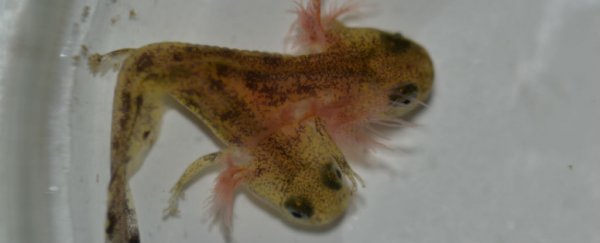A rare two-headed salamander has been born at the University of Haifa in Israel, and researchers don't know why. But no one panic, it's okay - he's not radioactive.
The two-headed Near Eastern fire salamander (Salamandra infraimmaculata) was born in the lab of ecologist Leon Blaustein, who has cautiously put it down to either a random mutation or environmental pollution. But at this point, he says he can only speculate.
The baby salamander was born from a wild pregnant female collected from Kaukab Springs in the Galilee Mountains of Israel. Unlike many salamander species, the Near Eastern fire salamander doesn't lay eggs - instead it gives birth to live young in a tadpole state.
According to Stephanie Pappas at LiveScience, both of the heads move, but only one has been seen eating anything. "Blaustein gave the heads their names to honour two German scientists, Arne Nolte and Sebastian Steinfartz, with whom he collaborates on studying fire salamander ecology," says Pappas.
While Blaustein says that salamander deformities are rare - two heads particularly so - his lab has also recorded cases of six-legged and partially-headed salamanders.
Globally, these amphibians have been classified as 'near threatened', but the population in Israel is considered to be endangered due to human interference and water pollution. It could be a change in radiation levels where its mother lived, but Blaustein was careful to say that the two-headed tadpole is not radioactive. One of the biggest problems for wild salamanders in Israel, Blaustein told Pappas, is people accidentally running over them with their cars.
According to Blaustein, salamanders act as a powerful indication for the general health of their environment, because they're particularly sensitive to changes in pollution levels. "And the Kaukab Springs site is one of the more polluted breeding sites for these salamanders," says Pappas at LiveScience. "However, those factors alone do not prove that pollution caused the defect."
Here's the cute little guy swimming and getting confused about which direction to take:

